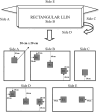Physical durability and insecticidal activity of long-lasting insecticidal nets in Cruzeiro do Sul, Brazil
- PMID: 38641670
- PMCID: PMC11031583
- DOI: 10.1038/s41598-024-59172-7
Physical durability and insecticidal activity of long-lasting insecticidal nets in Cruzeiro do Sul, Brazil
Abstract
Vector control is one of the principal strategies used for reducing malaria transmission. Long-lasting insecticidal bed nets (LLINs) are a key tool used to protect populations at risk of malaria, since they provide both physical and chemical barriers to prevent human-vector contact. This study aimed to assess the physical durability and insecticidal efficacy of LLINs distributed in Cruzeiro do Sul (CZS), Brazil, after 4 years of use. A total of 3000 LLINs (PermaNet 2.0) were distributed in high malaria risk areas of CZS in 2007. After 4 years of use, 27 'rectangular' LLINs and 28 'conical' LLINs were randomly selected for analysis. The evaluation of physical integrity was based on counting the number of holes and measuring their size and location on the nets. Insecticidal efficacy was evaluated by cone bioassays, and the amount of residual insecticide remaining on the surface of the LLINs was estimated using a colorimetric method. After 4 years of use, physical damage was highly prevalent on the rectangular LLINs, with a total of 473 holes detected across the 27 nets. The upper portion of the side panels sustained the greatest damage in rectangular LLINs. The overall mosquito mortality by cone bioassay was < 80% in 25/27 rectangular LLINs, with panel A (at the end of the rectangular bednet) presenting the highest mortality (54%). The overall mean insecticide concentration was 0.5 µg/sample, with the bednet roof containing the highest average concentration (0.61 µg/sample). On the conical LLINs, 547 holes were detected, with the bottom areas sustaining the greatest damage. The cone bioassay mortality was < 80% in 26/28 of the conical LLINs. The mean insecticide concentration was 0.3 µg/sample. After 4 years of use, the insecticidal efficacy of the LLINs was diminished to below acceptable thresholds.
Keywords: Long-lasting insecticidal nets; Malaria; Vector control.
© 2024. The Author(s).
Conflict of interest statement
The authors declare no competing interests.
Figures






References
-
- World Health Organization. World Malaria Report: 20 years of global progress and challenges. World Health Organization (2020).
-
- Brasil. Projeto para prevenção e controle da malária na Amazônia Brasileira. (2009).
-
- Ministério da Saúde. Guia para Gestão Local do Controle da Malária—Controle Vetorial. Ministério da Saúde (2009).
-
- Sivep-Malária, B. Ministério da Saúde & Secretaria de Vigilância em Saúde. SIVEP-MALÁRIA. http://www.saude.gov.br/sivep_malaria.
MeSH terms
Substances
Grants and funding
LinkOut - more resources
Full Text Sources
Medical

